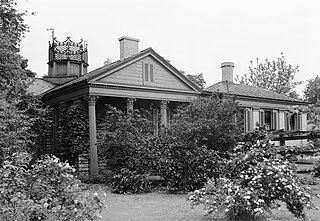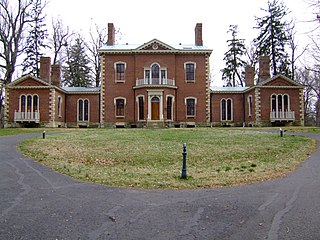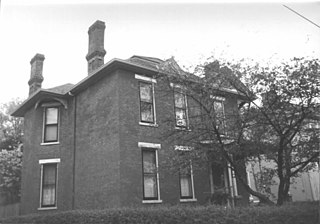Related Research Articles

John Pope was a United States Senator from Kentucky, a member of the United States House of Representatives from Kentucky, Secretary of State of Kentucky, and the third Governor of Arkansas Territory.
Cincinnatus Shryock was an American architect. A number of his works are listed on the U.S. National Register of Historic Places.

The Gratz Park is a neighborhood and historic district located just north of downtown Lexington, Kentucky. It was named after early Lexington businessman Benjamin Gratz whose home stands on the corner of Mill and New streets at the edge of Gratz Park. The historic district consists of 16 contributing buildings including the Hunt-Morgan House, the Bodley-Bullock House, the original Carnegie library in Lexington, and several other private residences. Gratz Park occupies a tract of land that was established in 1781 outside the original boundaries of Lexington.

William Christmas Knighton was an American architect best known for his work in Oregon. Knighton designed the Governor Hotel in Portland, Johnson Hall at the University of Oregon, and the Oregon Supreme Court Building and Deepwood Estate in Salem. He served as Oregon's first state architect from 1911–1915, appointed by Governor Oswald West. By 1915, Knighton had designed ninety building projects as state architect. In 1919, Knighton was appointed by Governor Ben Olcott as the first president of the Oregon State Board of Architectural Examiners, a position he held until 1922. In 1920, Knighton was elected the sixth president of the Oregon Chapter of the American Institute of Architects. He remained on the chapter's board of trustees for several years and was chair of the Chapter Legislative Committee into the 1930s.
Kennedy House or Kennedy Farm or Kennedy Cottage or Kennedy Mansion may refer to:

John McMurtry was a 19th-century American builder and architect who worked in Lexington, Kentucky designing a number of notable buildings, several of which are listed on the National Register of Historic Places.
Steele House may refer to:

Thomas Lewinski was an architect in Kentucky, United States. Born in England, he immigrated to the United States. For his work at Allenhurst and elsewhere, Lewinski was known in his day as one of the leading architects of the Greek Revival style. He designed many architecturally significant buildings that survive and are listed on the United States National Register of Historic Places.
Richard Karl August Kletting was an influential architect in Utah. He designed many well-known buildings, including the Utah State Capitol, the Enos Wall Mansion, the original Salt Palace, and the original Saltair Resort Pavilion. His design for the Utah State Capitol was chosen over 40 competing designs. A number of his buildings survive and are listed on the U.S. National Register of Historic Places including many in University of Utah Circle and in the Salt Lake City Warehouse District.
Charles E. Choate was a U.S. architect who worked in Georgia, Florida, and Alabama. He designed numerous buildings that are listed on the U.S. National Register of Historic Places.

James G. Hill (1841–1913) was an American architect who, during the period 1876 to 1883, headed the Office of the Supervising Architect of the United States Department of the Treasury, which oversaw major Federal buildings.

Woodward Heights is a neighborhood and historic district located immediately west of downtown Lexington, Kentucky. It is bounded by Maxwell Street and the Pleasant Green Hill neighborhood to the southwest, by the parking lot for Rupp Arena to the southeast, by the Lexington Convention Center property to the northeast, and by Herlihy, Cox, and High Streets to the north.

James J. Gaffney, most often known as J. J. Gaffney, was an American architect in Louisville, Kentucky.

Kilham & Hopkins was an architectural firm in Boston, Massachusetts formed in 1899 or 1900 by its founding members, Walter Harrington Kilham and James Cleveland Hopkins. The firm later became Kilham, Hopkins & Greeley after William Roger Greeley joined the firm in 1916, and Kilham Hopkins Greeley and Brodie after Walter S. (Steve) Brodie joined the firm in 1945.

Frankel & Curtis was an architectural firm of Lexington, Kentucky. It was a partnership of Leon K. Frankel and of John J. Curtis, along with associates James Slaughter Frankel and Melbourne Mills. A successor name is Frankel, Curtis & Coleman. Under this name, the firm received a 1963 American Institute of Architects Kentucky award, its Honor Award merit prize, for its Admin. Bldg., of the Spindletop Research Center, in Lexington, Kentucky.

Snow Hill, on Brush Creek in rural Bourbon County, Kentucky near Little Rock, Kentucky, was built in 1840. It was listed on the National Register of Historic Places in 1997.

The Walker Buckner House, in Bourbon County, Kentucky near Paris, Kentucky, was built in 1841. It has also been known as Buknore and as Locust Grove. It was listed on the National Register of Historic Places in 1997.
Herman L. Rowe was an architect active in Lexington, Kentucky. He was an immigrant from Germany. A couple of his works are listed on the U.S. National Register of Historic Places (NRHP).
John Scudder Adkins was an American architect who specialized in Beaux Arts, Tudor, and Jacobethan styles in the first half of the 20th century.
References
- 1 2 William M. Johnson (July 14, 1997). "National Register of Historic Places Registration: Snow Hill / Wilson Station; BB220". National Park Service . Retrieved April 15, 2019. With accompanying four photos from 1997
- 1 2 "Matthew Kennedy (frame) House". rootsweb. Retrieved April 15, 2019.